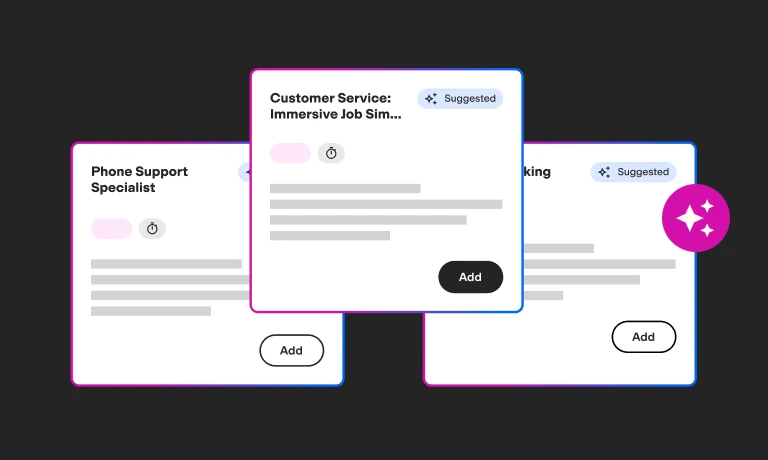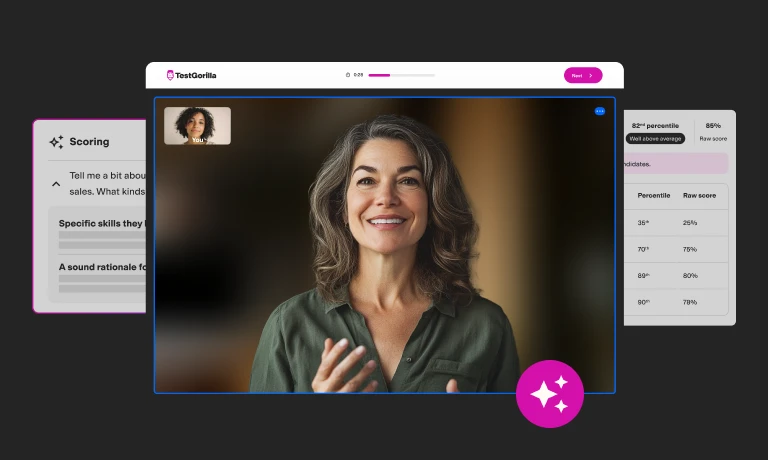Imagine hiring someone for a position that involves handling data in Excel – only to discover their skills fall short. The result? Lost productivity. Incomplete tasks, errors in reports, and a general slowdown in team efficiency can result from hiring someone lacking the right Excel proficiency.
You can avoid this by carefully assessing their Excel skills – and we can help.
In this guide, we explore the different levels of Excel proficiency and the skills they require – including some of the best Excel skills. We identify common challenges hiring managers face when assessing Excel proficiency and ways to avoid them.
The 3 levels of Excel proficiency
Excel proficiency falls into three main levels: basic, intermediate, and advanced. Here's an overview of each level.
Basic
At this level, employees can handle fundamental tasks like data entry and simple formulas. Here are the skills a candidate with basic Excel proficiency should have:
Basic data entry and formatting
Simple formula usage (e.g., SUM, AVERAGE)
Basic chart creation
Cell formatting and basic functions
Employees requiring this level of proficiency are entry-level employees who primarily use Excel for basic record-keeping and data management tasks. For example, a data entry clerk uses Excel for data entry and basic data organization, an administrative assistant for data management and record-keeping, and a receptionist for simple scheduling and contact lists.
Intermediate
Intermediate proficiency involves more advanced tasks. Candidates at this level can use moderately complex Excel functions. They can do the following:
Advanced formula usage (e.g., VLOOKUP, INDEX-MATCH)
Data sorting and filtering
Pivot table creation and manipulation
Conditional formatting
Employees at this level are typically analysts and mid-level professionals responsible for managing and analyzing data sets. For example, marketing managers use Excel for campaign analysis, supply chain coordinators for inventory data management, and human resources specialists for employee data analysis.
Advanced
Advanced Excel proficiency candidates can tackle complex tasks. This includes – but isn’t limited – to:
Complex formula creation and troubleshooting
Macros and VBA (Visual Basic for Applications) scripting
Advanced data analysis and modeling
Power Query and Power Pivot usage
Analysts and business intelligence professionals require this level of proficiency. They’re typically involved in intricate data analysis, modeling, and automation. To assess these specific skills, consider our Data Analytics in Excel test. Data scientists apply advanced statistical analysis and modeling in Excel, financial controllers manage complex financial reporting and analysis, and business intelligence analysts design and implement advanced dashboards and reports.
Key challenges in assessing Excel proficiency
Below are the common challenges hiring managers face when assessing Excel proficiency levels.
1. Candidates who don’t know their proficiency level
When you ask candidates about their Excel skills, they might have different ideas about what beginner, intermediate, or advanced means. People overestimate or underestimate their abilities, and this often results in a mismatch between what they believe they can do and their true skills.
2. New Excel features
Excel releases new features all the time. A candidate might be great with an older version but struggle with the latest release. If your organization keeps pace with the new Excel releases in your operations, such candidates won’t be able to keep up with your dynamic work environment.
3. Mismatched skills
Different jobs require different Excel skills. Some roles demand specific levels of Excel proficiency, whereas others require unique sets of Excel skills.
For example, someone who analyzes data must know more advanced Excel commands than someone who just enters data. Similarly, a project manager might need intermediate Excel collaboration skills, like tracking changes, while a financial analyst requires a different set of intermediate skills, such as building complex financial models.
Without proper assessments, you can end up hiring candidates who can’t perform the tasks the role demands.
The best insights on HR and recruitment, delivered to your inbox.
Biweekly updates. No spam. Unsubscribe any time.
What are the risks of hiring candidates without the required Excel proficiency?
Hiring candidates without the required Excel skills poses the following dangers.
1. Inaccurate data analysis
Hiring someone who struggles with Excel can lead to significant errors in data analysis, affecting critical business decisions. For instance, a financial analyst making mistakes in complex Excel formulas could produce inaccurate financial forecasts, potentially leading to misguided investments or budget allocations. This could have long-term financial repercussions for the company.
2. Delayed project completion
A new hire inefficient in Excel can cause significant project delays. For instance, an administrative assistant who takes too long to process and organize data in Excel might delay the submission of essential reports, leading to missed opportunities. This could ultimately affect the company's competitiveness.
3. Increased training costs
Employing someone lacking essential Excel skills can result in additional training expenses and time. This incurs direct costs for training programs and indirect costs due to lost productivity during the training period. It also potentially slows down other team members who must assist the new hire.
4. Bad business decisions
The inability to use Excel for effective scenario-based problem-solving can lead to bad strategic decisions. For example, a manager who fails to accurately model budget scenarios in Excel might allocate resources inefficiently, leading to underfunded critical projects or overspending, which can negatively impact the company's financial health and operational efficiency.
5. Integration and compatibility issues
Hiring someone unfamiliar with the specific Excel version used in your organization can create workflow inefficiencies. This is particularly problematic in roles that require integrating Excel data with other software. It can lead to data errors or compatibility issues, causing delays and potentially compromising data integrity.
6. Team dynamics and morale
In companies that use Excel for collaboration, hires without the needed Excel proficiency can disrupt team dynamics and lower morale. For instance, a project manager unable to effectively collaborate using Excel can create bottlenecks in team projects. This could lead to frustration, decreased morale, and reduced team productivity and cohesion.
How to test for the different levels of Excel proficiency
Accurately evaluating candidates' Excel skills is a must for roles involving Excel use. Asking candidates to evaluate their own skills or relying on the proficiency they claim to have on their resumes could lead to mis-hires. That's where assessments and strategic interviews come in.
TestGorilla is a talent assessment platform with hundreds of tests – some of which focus on assessing Excel skills. Here’s how to use TestGorilla’s tests to assess Excel proficiency.
Assessing basic Excel proficiency
For roles needing basic Excel skills, start with TestGorilla’s basic Excel Skills test. This way, you can check if candidates can handle fundamental tasks like data entry, simple formulas, and basic formatting.
Interviews can help, too. Ask candidates basic Excel interview questions about their Excel experience and knowledge. Look for evidence that they know common functions and can manage simple data tasks. For example, you might ask, “How do you protect Excel sheets?”
Measuring intermediate Excel proficiency
TestGorilla's intermediate Excel proficiency test checks whether candidates can work with larger datasets, use more advanced functions, and manipulate pivot tables effectively.
For intermediate roles, use interviews to discuss the candidate’s data analysis experience, asking for evidence of how they've used Excel to solve problems. For example, you might ask them to describe a time when they used Excel to identify a trend in a data set and to explain how they used their findings. You can also give them hypothetical scenarios involving complex tasks, asking how they’d approach these.
Evaluating advanced Excel proficiency
When hiring for positions requiring advanced Excel skills, you should assess candidates' ability to handle complex tasks like data modeling and automation. TestGorilla's Advanced Excel test challenges candidates with specific scenarios, ensuring they can create complex formulas, work with macros, and perform advanced data analysis.
Advanced Excel proficiency often intersects with strategic decision-making, so use advanced Excel interview questions to measure their strategic thinking and adaptability. During interviews, inquire about each candidate’s experience solving real business problems with Excel. Discuss their ability to use Excel for budget optimization, forecasting, and other strategic tasks.
Test your candidate’s Excel proficiency with TestGorilla
Understanding whether your candidates possess basic, intermediate, or advanced Excel skills is important to ensure you’re selecting the right candidate for the job. But this can be challenging.
Fortunately, TestGorilla can help. You can choose the Excel tests you need from our test library. You can also customize the tests with your own questions. Even better: you can combine five or fewer tests into a single assessment. Our tests include role-specific tests, cognitive ability tests, personality tests, and more.
Want to learn more? Take a quick product tour or sign up for our free plan today.
You've scrolled this far
Why not try TestGorilla for free, and see what happens when you put skills first.


















